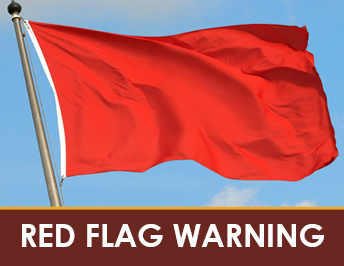Red Flag Warning What You Need to Know
Published: 10/14/2021
Red Flag Warning: What You Need to Know
Fire season is year-round in Southern California so taking precautions to protect yourself and loved ones is always important.
Red Flag Warnings & Santa Ana Winds
Extreme caution should be taken by all during a Red Flag Warning because a simple spark can cause a major fire.
- Skip the use of outdoor equipment requiring open flames such as fire pits, barbeques, heaters, candles, etc.
- Discard cigarettes or matches appropriately and NEVER on the ground.
- Avoid using lawnmowers or other landscaping tools that may emit sparks on dry vegetation.
- Never pull over in dry grass.
- Ensure trailer chains don't drag on the ground.
- Make sure your vehicle is properly maintained.
- Have proper tire pressure to avoid driving on wheel rim.
- Never let your brake pads wear too thin.
- If you encounter a downed power line, stay clear and immediately call 911.
Southern California Edison’s (SCE) Public Safety Power Shutoff (PSPS) events
Learn how weather conditions of relatively low humidity, strong winds, and hot temperatures in combination with dry fuels can also threaten power supply to our community.
Public Safety Power Shutoff (PSPS)
Weather & Fire Risks
Weather patterns like low relative humidity, strong winds, dry fuels, dry lightning strikes, or any combination of the above could lead to rapid or dramatic increases in wildfire activity. The National Weather Service issues Red Flag Warnings & Fire Weather Watches to alert fire departments of the onset, or possible onset, of critical weather conditions.
Red Flag Warning:
The highest alert when fire conditions are ongoing or expected to occur. When there is critical weather and dry conditions such as low humidity, strong winds, and dry fuels there is increased risks for potential fires.
Fire Weather Watch:
One level before a warning, where fire danger is high and fire weather conditions are possible but not imminent or occurring.
Fire Preparation Tips for Around the Home
Outside
- Clear leaves, pine needles and other debris from roofs, gutters, eaves, porches, and patios.
- Remove and dispose of dead vegetation like branches, weeds, leaves, pine needles, and grass clippings to reduce fuel for fire.
- Prune tree limbs so the lowest branches are 6 to 10 feet above the ground to help reduce the chance of fire spreading to treetops.
- Remove construction material, trash, and woodpiles at least 30 feet away from the home and other outbuildings.
Inside
- Install smoke alarms throughout your home and replace the batteries once per year.
- Test your smoke alarms monthly.
- Keep fire extinguishers nearby in high-risk fire areas like the kitchen and garage.
Helpful Resources
- For an Emergency: Dial 911
- Stay Safe. Stay Ready. : Take steps to become ready for any emergency
- For Non-emergency City Services: 311 App 311 Website (951) 826-5311
- Riverside Fire Department
- Stay up to date about emergencies near you with Ready Riverside our mass communication service. You will receive voice or text communication when there is a potential safety hazard or concern.


